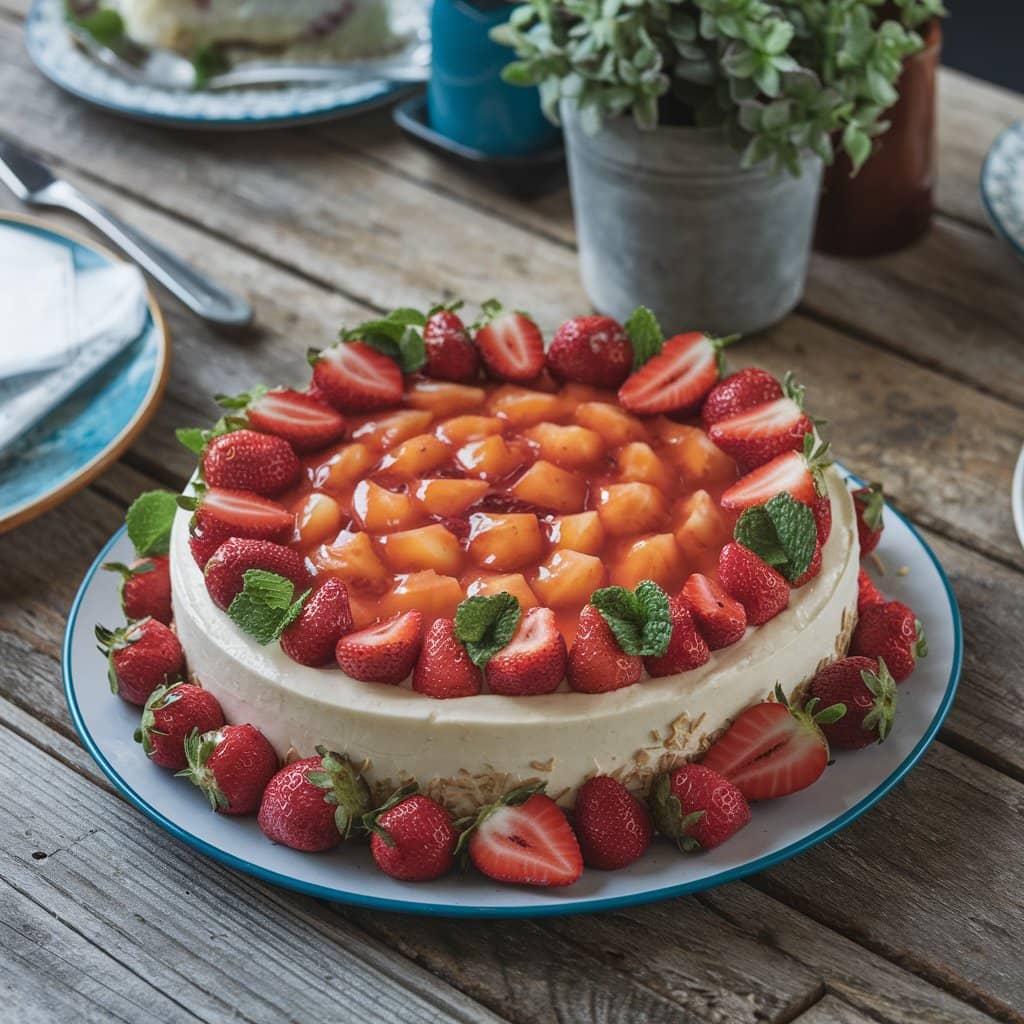What Is a Bavarian Cake Made Of? Bavarian cake, also known as Bavarian cream cake or Bavarois, is a luxurious dessert that blends creamy, airy textures with rich, sweet flavors. Originating from Bavaria, Germany, this cake is cherished worldwide for its elegant presentation and delightful taste. In this article, we’ll explore the essential ingredients and methods used to create this exquisite dessert, offering insight into what makes Bavarian cake so special.
Table of contents
History of Bavarian Cake
Origin and Cultural Significance
Bavarian-cake traces its roots back to 19th-century Bavaria, Germany. It was initially a delicacy served at royal banquets due to its intricate preparation. Chefs combined French culinary techniques with Bavarian dairy products, creating a dessert that symbolized elegance and refinement.
Evolution of the Recipe
As time passed, Bavarian cake recipes spread across Europe and beyond. Each culture added unique touches, incorporating local ingredients like fruits, chocolate, or nut-based layers. Today, Bavarian cake remains a popular dessert in upscale patisseries and home kitchens alike.
Core Ingredients in Bavarian Cake
Bavarian-cake is a harmonious blend of creamy and light elements, crafted with precision. To fully appreciate its delightful texture and rich flavor, it is important to understand the essential ingredients that come together to create this iconic dessert. Here’s a closer look at what makes Bavarian-cake so special:
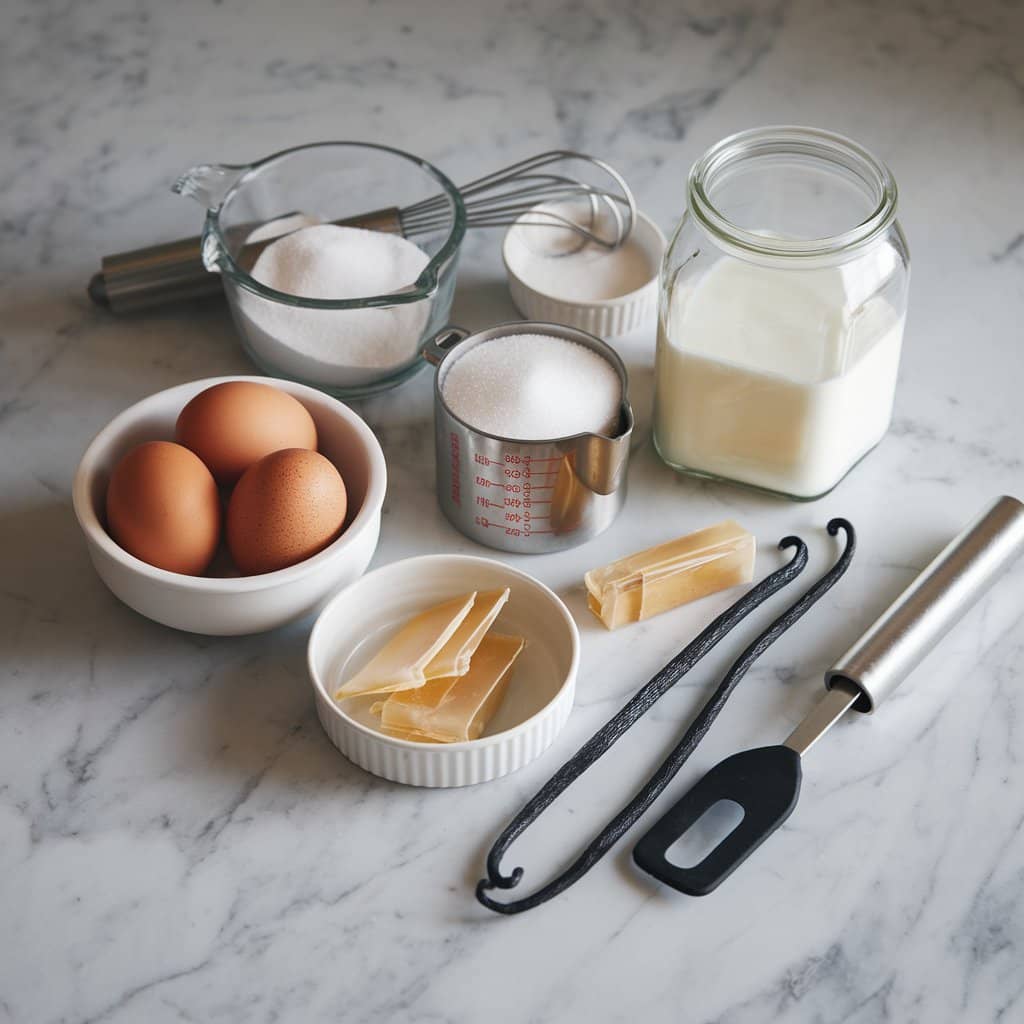
Custard Base
First and foremost, the custard base forms the foundation of Bavarian-cake, providing a creamy and luxurious texture. It includes several key components that work in harmony:
- Egg Yolks: These contribute richness while enhancing the cake’s smooth consistency. Without them, the custard would lack its characteristic silkiness.
- Sugar: In addition to sweetening the custard, sugar balances the flavors by mellowing the richness of the egg yolks.
- Milk or Cream: These ingredients are essential for achieving a velvety base. They add creaminess while ensuring the custard stays light and fluffy.
- Vanilla Extract or Bean: Vanilla not only enhances the overall taste but also adds a warm, inviting aroma.
Gelatin for Stability
Equally important, gelatin plays a critical role in stabilizing the custard and helping the cake maintain its structure.
- Gelatin Sheets or Powder: Whether using sheets or powder, gelatin must first be softened in cold water. Afterward, it is dissolved into the warm custard to ensure a firm yet delicate texture. This step is crucial to prevent the cake from collapsing.
Whipped Cream for Lightness
In addition to the custard, whipped cream is essential for creating the signature lightness of a Bavarian cake.
- Heavy Whipping Cream: After being whipped to soft peaks, the cream is gently folded into the custard. This step not only lightens the mixture but also adds a luxurious, airy texture. Careful folding prevents the custard from becoming dense or heavy.
Additional Flavorings and Enhancers
Moreover, Bavarian cake can be customized with various additional ingredients, depending on personal preferences or special occasions.
- Chocolate: Melted chocolate can be added for a rich, indulgent twist, making the dessert more decadent.
- Fruits: Fresh fruit purees such as strawberry, raspberry, or mango provide a refreshing and naturally sweet contrast.
- Liqueurs: Spirits like Grand Marnier or Kirsch not only add depth but also complement the cake’s sweetness with a hint of sophistication.
How Bavarian Cake Is Made
Creating a Bavarian cake involves precision, patience, and careful layering. Here’s a detailed step-by-step guide to making this elegant dessert:
1 – Preparing the Custard Base
- Heat the Milk: Warm the milk in a saucepan over medium heat until it just starts to simmer. Avoid boiling to prevent curdling.
- Whisk Egg Yolks and Sugar: In a separate bowl, whisk the egg yolks with sugar until the mixture turns pale and thick.
- Combine and Cook: Slowly pour the hot milk into the egg-sugar mixture, whisking constantly to prevent scrambling. Return this mixture to the saucepan.
- Cook the Custard: Stir gently over low heat until the custard thickens and coats the back of a spoon. Avoid overheating to prevent curdling.
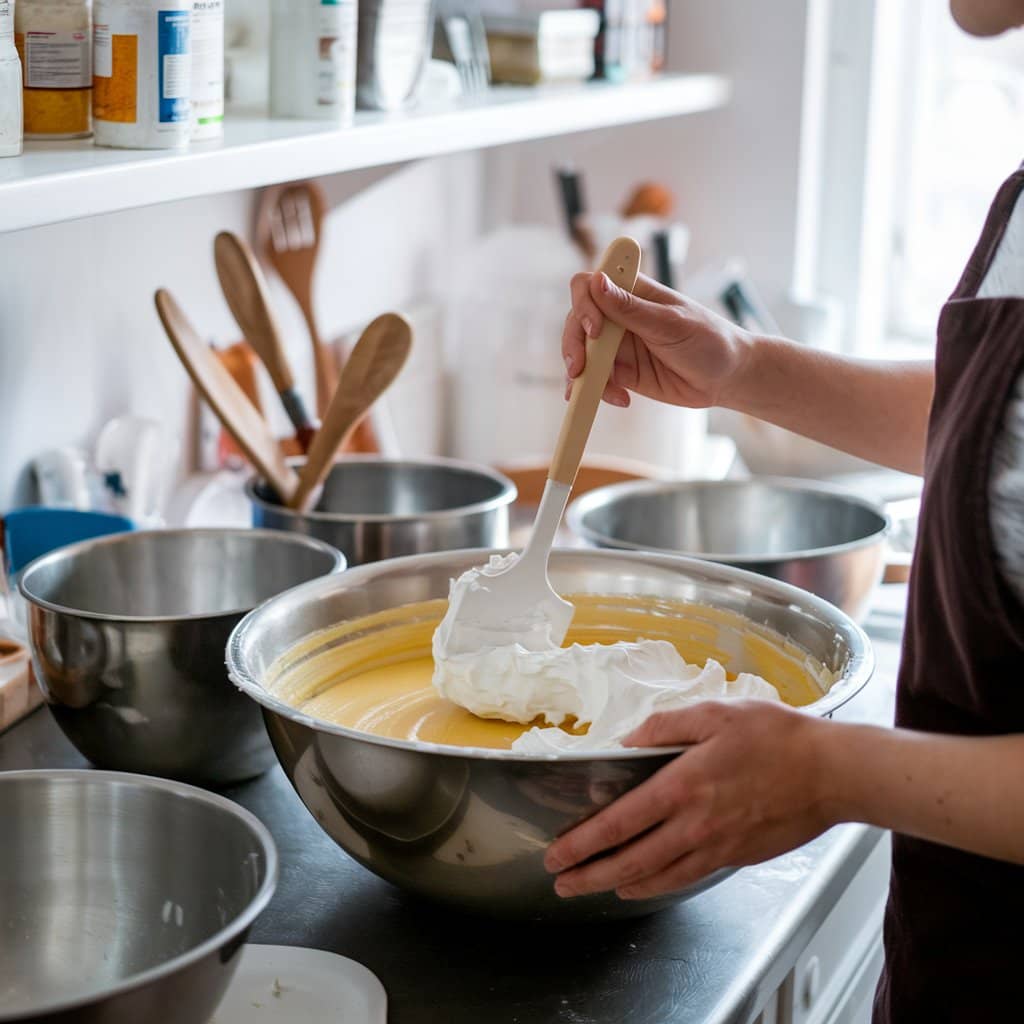
2 – Adding Gelatin for Structure
- Soften Gelatin: Soak gelatin sheets in cold water until soft. If using powdered gelatin, dissolve it in a small amount of water.
- Mix into Custard: Stir the softened gelatin into the warm custard until fully dissolved, ensuring no lumps remain. Allow the mixture to cool to room temperature.
3 – Folding in Whipped Cream
- Whip the Cream: Beat heavy cream until soft peaks form. Be careful not to over-whip.
- Fold Gently: Once the custard has cooled, gently fold in the whipped cream in batches. This step ensures a light, airy texture.
4 – Assembling the Cake
- Prepare the Mold: Use a cake ring or springform pan lined with sponge cake or ladyfingers as the base.
- Layer the Custard Mixture: Pour the custard-cream mixture over the cake base. Smooth the top with a spatula.
- Chill the Cake: Refrigerate the cake for at least 4-6 hours or overnight until fully set.
5 – Unmolding and Decoration
- Unmold Carefully: Gently release the cake from the mold using a warm, damp cloth wrapped around the sides.
- Decorate Creatively: Top the cake with fresh fruit, chocolate shavings, or a fruit glaze for an elegant finish.
Popular Variations of Bavarian Cake
Bavarian cake offers endless possibilities for customization. By adjusting the ingredients and flavors, pastry chefs and home bakers alike can create unique versions of this classic dessert. Here are some of the most popular variations:
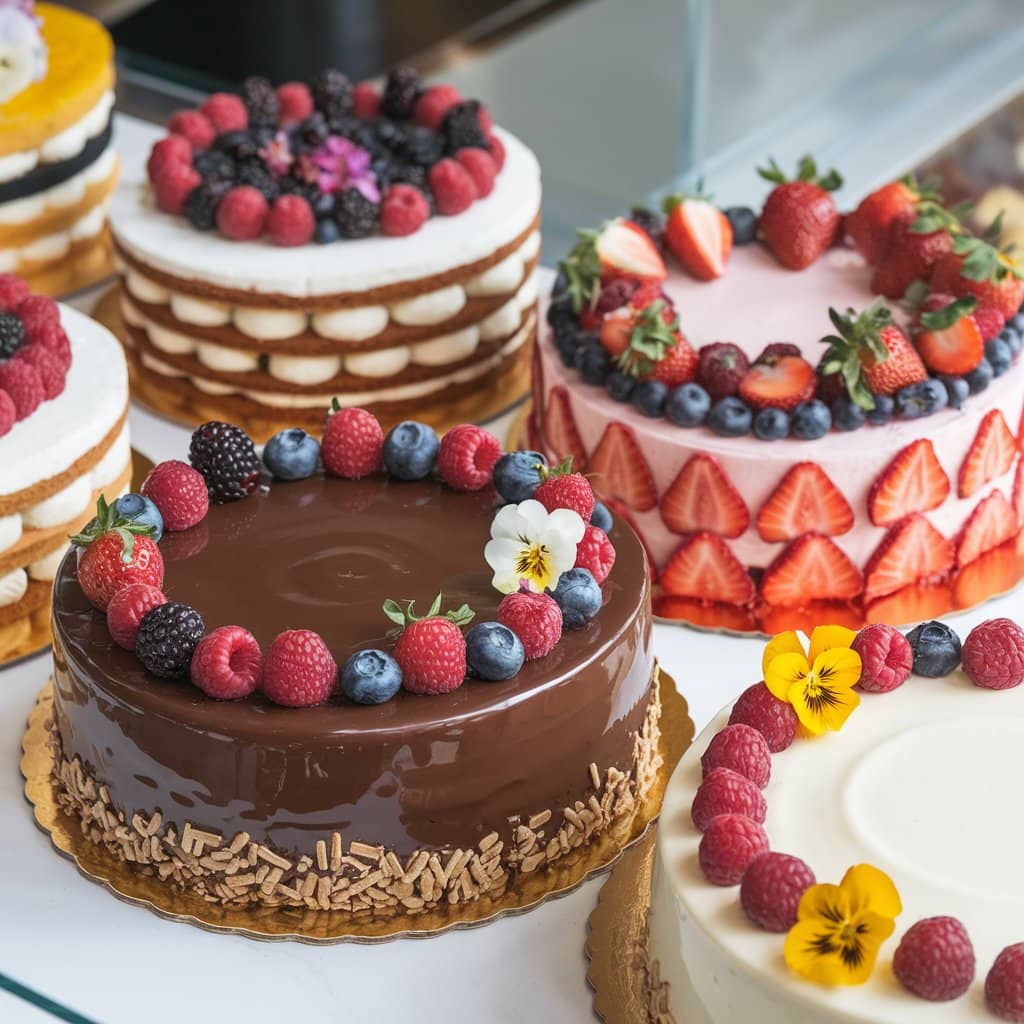
Fruit-Based Bavarian Cakes
1. Strawberry Bavarian Cake
- Description: A refreshing twist featuring layers of strawberry puree mixed into the custard.
- How It’s Made: Fresh strawberries are blended and strained to create a smooth puree, which is folded into the custard before adding whipped cream. The cake is typically topped with sliced strawberries or a strawberry glaze.
2. Mango Bavarian Cake
- Description: A tropical version using sweet mango puree for a burst of exotic flavor.
- How It’s Made: Fresh mango puree is added to the custard base, complemented by a light sponge cake layer and a glossy mango topping.
3. Raspberry Bavarian Cake
- Description: Tangy and sweet, this version pairs perfectly with chocolate or vanilla bases.
- How It’s Made: Raspberries are pureed and incorporated into the custard mixture, giving the cake a vibrant pink hue and a deliciously tart flavor.
Chocolate-Based Bavarian Cakes
1. Classic Chocolate Bavarian Cake
- Description: Rich and indulgent, made with melted chocolate blended into the custard.
- How It’s Made: Dark chocolate is melted and mixed into the custard before folding in whipped cream. Layers of chocolate sponge cake add extra depth.
2. Mocha Bavarian Cake
- Description: A coffee-flavored treat perfect for caffeine lovers.
- How It’s Made: Espresso powder or brewed coffee is added to the custard and chocolate base, creating a luxurious mocha flavor profile.
Alcohol-Infused Bavarian Cakes
1. Grand Marnier Bavarian Cake
- Description: A citrus-inspired dessert infused with Grand Marnier liqueur.
- How It’s Made: A touch of Grand Marnier is added to the custard, enhancing its citrus notes. It pairs well with orange slices or candied zest as decoration.
2. Kirsch Bavarian Cake
- Description: A traditional cake often made with cherry liqueur (Kirsch).
- How It’s Made: Kirsch is incorporated into the custard for a subtle cherry flavor, often combined with fresh cherries or a cherry glaze.
Modern Twists and Innovations
1. Matcha Bavarian Cake
- Description: A contemporary twist featuring matcha green tea powder.
- How It’s Made: Matcha is blended into the custard for a unique, earthy flavor that pairs well with white chocolate or citrus fruits.
2. Vegan Bavarian Cake
- Description: A plant-based adaptation made with non-dairy ingredients.
- How It’s Made: Coconut milk or almond milk replaces dairy cream, while agar-agar is used instead of gelatin for setting the custard.
Tips for Making the Perfect Bavarian Cake
Crafting a flawless Bavarian cake requires precision, patience, and attention to detail. Here are expert tips to help you achieve a perfect result every time:
Mastering the Custard Base
- Use Fresh Ingredients: Always use the freshest eggs, cream, and milk for the best flavor and texture.
- Prevent Curdling: Cook the custard over low heat, stirring continuously to avoid curdling. Use a thermometer to keep the temperature below 180°F (82°C).
- Strain the Custard: After cooking, strain the custard through a fine mesh sieve to remove any lumps or egg solids.
Handling Gelatin Properly
- Soften Gelatin Correctly: Always soften gelatin in cold water before use. This prevents clumping when added to the custard.
- Dissolve Completely: Stir the softened gelatin into the hot custard while it’s still warm, ensuring it dissolves fully.
Perfectly Whipping the Cream
- Keep It Cold: Chill the mixing bowl and whisk before whipping the cream to achieve maximum volume.
- Avoid Over-Whipping: Whip the cream only until soft peaks form. Over-whipping can result in a grainy texture.
Proper Folding Technique
- Gentle Folding: Use a spatula to fold the whipped cream into the custard gently. This keeps the mixture light and airy.
- Avoid Over-Mixing: Mix just enough to combine the ingredients. Over-mixing can deflate the air from the whipped cream.
Assembling and Chilling
- Use a Mold: Use a cake ring or springform pan to shape the Bavarian cake. Line the bottom with a sponge cake or ladyfingers.
- Smooth the Top: Level the surface with a spatula for a clean finish.
- Chill Thoroughly: Allow at least 4-6 hours for the cake to set properly in the refrigerator. Overnight chilling is ideal for better firmness.
Decorating and Serving
- Choose the Right Toppings: Fresh fruits, fruit glaze, chocolate shavings, or a dusting of cocoa powder enhance both flavor and appearance.
- Serve Chilled: Keep the cake refrigerated until ready to serve to maintain its firm texture.
Troubleshooting Common Issues
- Runny Cake: If the cake is too soft or runny, check that the gelatin was properly dissolved and that the cake was chilled long enough.
- Curdled Custard: This occurs when the custard is overcooked. Straining the mixture can salvage it if curdling is minimal.
- Lumpy Texture: Ensure the gelatin is fully dissolved and folded evenly into the custard for a smooth finish.
Serving and Presentation Ideas for Bavarian Cake
Presentation plays a crucial role in elevating Bavarian cake from a simple dessert to an eye-catching masterpiece. Here are creative ways to serve and present this elegant treat:
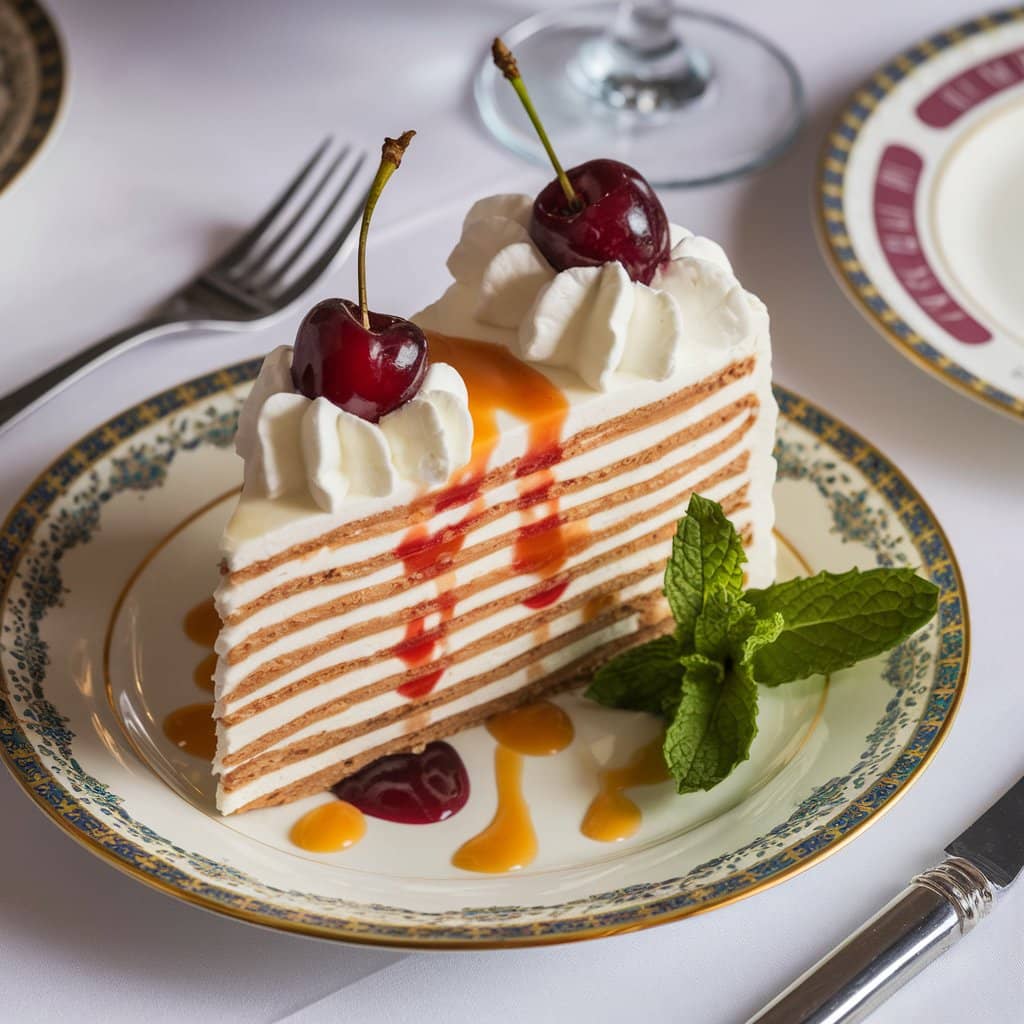
Classic Presentation Styles
- Whole Cake Display:
- How to Serve: Unmold the cake carefully onto a decorative cake stand. Use a warm knife for a clean release.
- Decoration Ideas: Add fruit toppings, fresh berries, or edible flowers. Finish with a light dusting of powdered sugar.
- Individual Portions:
- How to Serve: Pour the Bavarian cream into individual molds or ramekins. After chilling, unmold onto plates.
- Decoration Ideas: Use chocolate curls, caramel drizzle, or a dollop of whipped cream for added elegance.
Toppings and Garnishes
- Fruit Glazes:
- Best Choices: Strawberry, raspberry, or apricot glaze adds shine and a burst of flavor.
- Application: Pour the glaze gently over the top and spread with a spatula for a smooth finish.
- Fresh Fruits and Berries:
- Best Options: Sliced strawberries, raspberries, blueberries, or kiwi add vibrant color and freshness.
- Placement Tip: Arrange in a symmetrical pattern for a polished look.
- Chocolate Decorations:
- Types to Use: Use chocolate curls, shards, or drizzles for an indulgent touch.
- How to Apply: Sprinkle over the top or create decorative borders.
- Edible Flowers:
- Best Choices: Pansies, violets, or rose petals add elegance and a touch of luxury.
- Use Caution: Ensure flowers are organic and food-safe.
Plating and Pairing Suggestions
- Elegant Plating:
- Use wide, white plates to make the dessert stand out. Add a drizzle of fruit coulis or a chocolate swirl for contrast.
- Complementary Pairings:
- Beverages: Serve with coffee, espresso, or dessert wine like Moscato or Champagne.
- Side Options: Pair with a scoop of vanilla ice cream, a fruit sorbet, or a crunchy biscuit for texture contrast.
Special Occasion Presentation
- Layered Display: Create a multi-layered Bavarian cake with alternating layers of sponge cake and mousse. Use transparent molds for a dramatic effect.
- Themed Decorations: Customize the cake for holidays or events by adding seasonal fruits or decorative toppers.
- Mirror Glaze Finish: For a professional patisserie look, use a mirror glaze for a shiny, reflective surface that wows any crowd.
Frequently Asked Questions (FAQs) About Bavarian Cake
Here are answers to some common questions about Bavarian cake, from its ingredients to preparation tips.
FAQ 1: What Is Bavarian Cake Made Of?
Bavarian cake is primarily made of a custard base (egg yolks, sugar, milk), stabilized with gelatin, and lightened with whipped cream. The mixture is poured over a sponge cake or ladyfinger base and chilled until set. It can be flavored with fruits, chocolate, or liqueurs.
FAQ 2: Is Bavarian Cake the Same as Bavarian Cream?
Not exactly. Bavarian cream is the mousse-like filling used in Bavarian cake. Bavarian cake includes a base layer (like sponge cake), while Bavarian cream can be served on its own or as a filling for pastries like éclairs or cream puffs.
FAQ 3: How Long Does It Take to Set a Bavarian Cake?
Bavarian cake typically needs at least 4-6 hours in the refrigerator to set properly. For the best results, chilling it overnight ensures firmness and easier slicing.
FAQ 4: Can I Make Bavarian Cake Ahead of Time?
Yes, Bavarian cake is an ideal make-ahead dessert. It can be prepared up to two days in advance and stored in the refrigerator. This allows the flavors to meld, enhancing the overall taste.
FAQ 5: Why Is My Bavarian Cake Not Setting?
If the cake doesn’t set, it’s likely due to incorrect gelatin preparation. Ensure the gelatin is fully dissolved in the custard while it’s still warm. Also, verify that the cake has chilled long enough, preferably overnight.
FAQ 6: Can I Freeze Bavarian Cake?
Freezing Bavarian cake is not recommended, as its creamy texture can break down during thawing, resulting in a watery, separated dessert. For best results, enjoy the cake freshly chilled from the refrigerator.
FAQ 7: What Is the Best Cake Base for Bavarian Cake?
The most common cake bases are sponge cake, genoise, or ladyfingers. These light cakes absorb moisture while providing structure, enhancing the cake’s overall texture.
Conclusion
Bavarian cake is a timeless dessert celebrated for its creamy texture, delicate sweetness, and versatile flavor combinations. Its unique blend of custard, whipped cream, and gelatin creates a luxurious treat that can be customized with fruits, chocolate, or liqueurs. Whether served at elegant gatherings or enjoyed as a homemade delight, Bavarian cake never fails to impress with its sophisticated appearance and heavenly taste.
By following the expert tips and creative presentation ideas shared in this article, you can master the art of making Bavarian cake and adapt it to fit any occasion. From classic fruit-based variations to modern interpretations, this iconic dessert promises a delightful experience for both bakers and dessert lovers alike.

